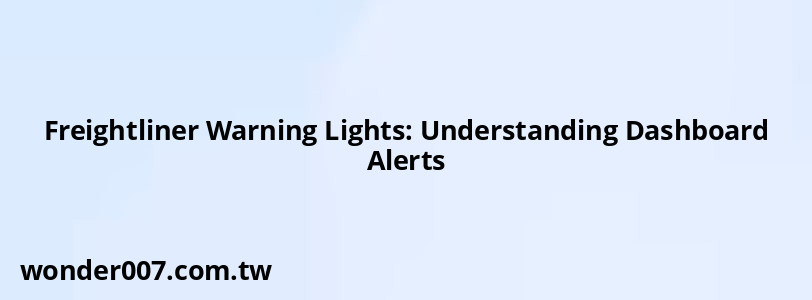Freightliner Warning Lights: Understanding Dashboard Alerts

Freightliner trucks are equipped with a variety of warning lights on the dashboard that alert drivers to potential issues with the vehicle. Understanding these lights is crucial for maintaining safety and vehicle performance. This guide will help you interpret the most common Freightliner warning lights, their meanings, and what actions to take when they illuminate.
Common Freightliner Warning Lights
Freightliner vehicles feature a range of warning lights, each corresponding to specific vehicle conditions. Here are some of the most significant warning indicators:
Stop Engine Warning
This red light indicates a critical issue requiring immediate attention. If illuminated, the driver should stop the engine as soon as it is safe to do so.
Check Engine Light
The check engine light can indicate various issues, from minor faults to severe engine problems. It’s essential to have the vehicle checked by a technician if this light remains on.
Low Oil Pressure Warning
This light activates when oil pressure falls below safe levels. Ignoring this warning can lead to severe engine damage.
High Coolant Temperature
When this light turns on, it signals that the engine coolant temperature is too high. Drivers should pull over and allow the engine to cool down.
Low Air Pressure Warning
This indicator alerts drivers when air pressure in the brake system drops below safe levels. Immediate action is necessary to avoid brake failure.
Transmission Overheat Warning
If this light appears, it indicates that the transmission fluid temperature is excessively high. The driver should stop and allow the transmission to cool.
ABS Warning
The Anti-lock Braking System (ABS) warning light illuminates if there’s a malfunction in the ABS system. This does not mean that brakes will fail but indicates reduced braking effectiveness.
Water in Fuel Indicator
This light warns of water contamination in the fuel system. It’s crucial to drain any water from the fuel/water separator immediately.
Diesel Particulate Filter (DPF) Light
When this light is illuminated, it indicates that the DPF requires cleaning or there is an issue with exhaust emissions.
Importance of Understanding Warning Lights
Understanding what each warning light signifies is vital for safe driving and vehicle maintenance. Ignoring these indicators can lead to serious mechanical failures or accidents. Drivers should familiarize themselves with their specific Freightliner model's dashboard symbols, as they may vary slightly between models.
FAQs About Freightliner Warning Lights
- What should I do if a warning light comes on?
Immediately check your owner's manual for guidance on that specific warning light and take appropriate action. - Are all warning lights urgent?
No, some lights indicate non-critical issues that should be addressed soon, while others require immediate attention. - Can I continue driving if a warning light is on?
It depends on the light; critical warnings like "Stop Engine" require immediate action, while others may allow for continued driving until it's safe to stop.
By being proactive and responsive to dashboard warnings, drivers can ensure their Freightliner operates safely and efficiently, minimizing downtime and repair costs.
Related Posts
-
Ford Edge: Understanding Engine Coolant Over Temperature Issues
29-01-2025 • 337 views -
Electronic Throttle Control Warning Light Explained
26-01-2025 • 229 views -
Multiple Warning Lights on Subaru Dashboard: Causes
26-01-2025 • 185 views -
Dodge RAM 1500: Understanding Warning Lights and Symbols
26-01-2025 • 173 views -
Dodge Durango: Dashboard Warning Lights and Symbols Guide
26-01-2025 • 242 views
Latest Posts
-
How To Turn Off Paddle Shifters Mercedes
01-02-2025 • 377 views -
Power Steering Fluid Leak On Passenger Side
01-02-2025 • 457 views -
Rear Brake Caliper Piston Won't Compress
01-02-2025 • 356 views -
Are O2 Sensors Covered Under Warranty
01-02-2025 • 376 views -
2015 Chevy Traverse AC Recharge Port Location
01-02-2025 • 409 views
Popular Posts
-
Hino Warning Lights: Understanding Dashboard Alerts
26-01-2025 • 765 views -
V12 Engine Costs: What You Need to Know
26-01-2025 • 679 views -
Power Steering and ABS Light On: Causes and Solutions
27-01-2025 • 643 views -
EPC Light: Understanding Causes and Solutions
26-01-2025 • 1053 views -
EPC Warning Light: What It Means for Your Vehicle
27-01-2025 • 630 views
